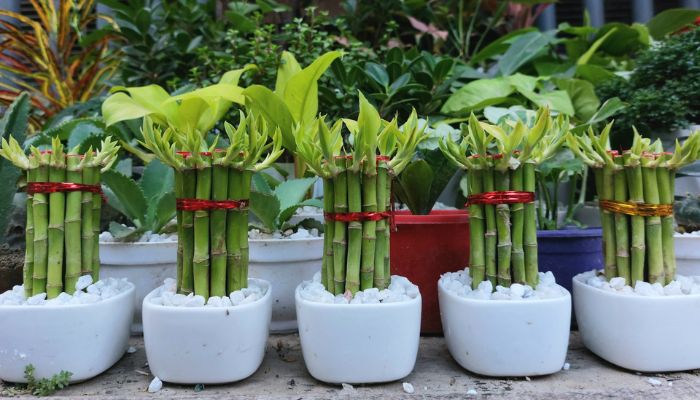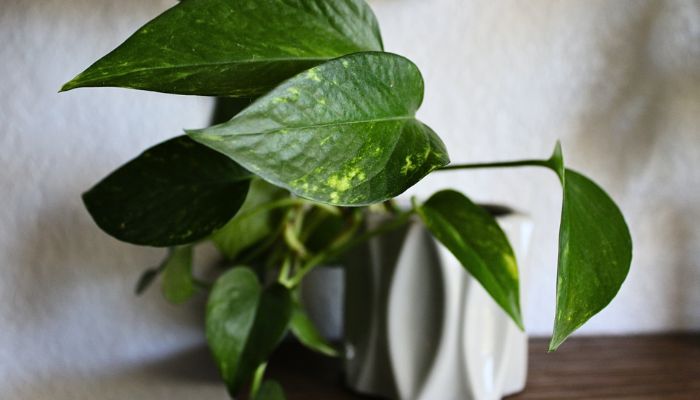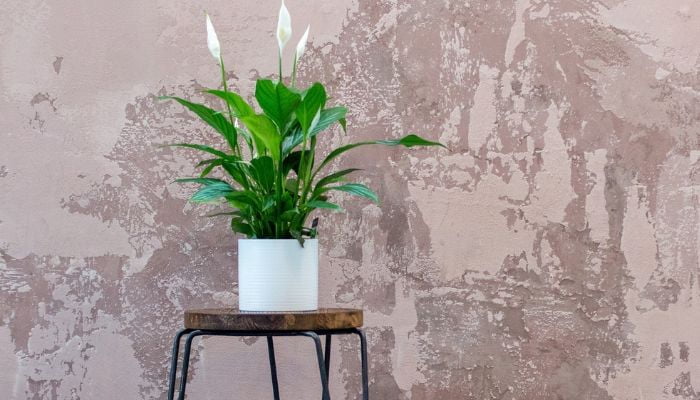Are you looking for the best low-light indoor plants for your home? Indoor gardening is one of the trickier tasks as lighting situations can make it difficult for the indoor gardener. But no need to worry, there are many low-light loving indoor plants to choose from if you don’t have a lot of sunny windowsills.
Low-light houseplants will thrive mainly in an east or west-facing room with a window or two, even if they do not receive direct sunlight. However, remember that even the most shade-tolerant plants will struggle in a room with no windows or a single north-facing window. In that case, turning on artificial lights for a few hours each day might help your plants.
Best Low-Light Indoor Plants
Low-light houseplants are ideal for new gardeners or those with little time to give to their plants. These plants can survive in locations with little natural light, making them excellent for apartments, offices, and other small spaces.
1. Lucky Bamboo (Dracaena sanderiana)
Lucky bamboo plants may be grown in either water or soil and are appropriate for both offices and residences. They frequently have sculptural or braided stalks dotted with little green leaves. Lucky bamboo plants, an essential component of feng shui practice, and considered to bring good luck and wealth, especially if given as a gift.
They also have a well-deserved reputation for being practically indestructible. Lucky bamboo prefers some light but will flourish in nearly complete darkness. Just make sure they aren’t in draughty sections of your house. Further, they are poisonous to pets, so keep them away from them.

Light: Partial shade to full shade
Leaf Color Varieties: Green
Mature Size: 1 to 5 ft tall, 1 to 2 ft wide (indoors)
Maintenance Difficulty: Low-maintenance
2. Spider Plant (Chlorophytum comosum)
Spider plants are one of the most popular low-light houseplants ideal for beginners. These plants are relatively easy to care for and can handle various lighting conditions. They’re also known for being drought tolerant, making them an excellent choice for individuals who forget to water their plants frequently.
Light: Partial Shade
Leaf Color Varieties: Green or variegated foliage
Mature Size: 1 to 2 ft tall and wide
Maintenance Difficulty: Low-maintenance

3. Snake Plant (Sansevieria trifasciata)
It’s straightforward to see why snake plants are one of the most popular low-light houseplants. These tough plants may survive in various lighting environments, including both low and bright light. They’re also extremely simple to care for, making them an excellent choice for new gardeners.

Light: Partial shade
Leaf Color Varieties: Deep green foliage with a striped edge and gray-green markings
Mature Size: 6 inches to 12 ft tall
Maintenance Difficulty: Low-maintenance
4. Golden Pothos (Epipremnum aureum)
Golden pothos can flourish in situations that nearly no other plant can, such as very low light and a near-complete lack of water. It is one of the most popular houseplants due to its gorgeous, long-lasting, and simple-to-grow vines with smooth, leathery, heart-shaped leaves.
Some types feature leaves with pronounced marbling that alternate along rope-like green stems. To keep the vines from becoming tangled, loosen and dust them on a regular basis. Long stems react nicely to trimming to keep them manageable and encourage branching. Since the plant is unsafe for pets, keep them away.
Light: Partial shade to full shade
Leaf Color Varieties: Green or variegated foliage
Mature Size: 20 to 40 ft long, 3 to 6 ft wide
Maintenance Difficulty: Low-maintenance

5. Philodendron (Philodendron spp.)
Philodendrons are a type of vine that may bring a touch of elegance to any setting. These plants thrive in low-light environments and are quite simple to maintain. They can be cultivated in potting soil or hydroponically, making them an excellent alternative for new gardeners. Because philodendrons are toxic, keep them away from children and dogs.

Light: Partial shade
Leaf Color Varieties: Green
Mature Size: 10 to 25 ft tall, 3 to 6 ft spread
Maintenance Difficulty: Low-maintenance
6. Peace Lily (Spathiphyllum)
Peace lilies are a sort of flowering plant that can brighten up any room. These plants thrive in low-light environments and are quite simple to maintain. They’re also one of the greatest plants for filtering toxins from the air, making them an excellent choice for anyone trying to improve the air quality in their home. These shade-loving plants should be planted in an area with indirect light. Since the plant is toxic, keep it away from children and dogs.
Light: Partial shade to full shade
Leaf Color Varieties: Dark green foliage, white flowers
Mature Size: 1 to 5 ft tall and wide (indoors)
Maintenance Difficulty: Low-maintenance

Also Read:
7. Anthurium (Anthurnium spp.)
Anthurium, popularly known as the flamingo flower, is a tropical plant genus with vibrant blossoms and lush leaves. These plants can be grown indoors with high humidity and persistently damp but not saturated soil. The leaves can be burned by direct sunlight, so choosing a position that receives bright, indirect light is ideal. Since these plants are toxic by nature, keep them away from children and pets.

Light: Partial shade
Leaf Color Varieties: Red, pink, or white flowers
Mature Size: 12 to 20 inches tall, 10 to 12 inches wide
Maintenance Difficulty: High-maintenance
8. Swiss Cheese Plant (Monstera Deliciosa)
Swiss cheese plant, commonly known as split-leaf philodendron, has huge, leathery, green leaves with noticeable perforations. These plants thrive in shaded environments and flourish in bright, indirect light indoors. Too much light might burn this plant. Further, these plants are toxic to pets so keep them away.
Light: Partial shade
Leaf Color Varieties: Green
Mature Size: 3 ft tall, 2 to 3 ft spread
Maintenance Difficulty: Low maintenance

9. Polka Dot Plant (Hypoestes phyllostachya)
Polka dot plants are grown for their visually appealing foliage. They often have leaves with pink or white dots, though different colors are available. Both indoors and outdoors, these plants prefer a little shade. Too much sun might cause the foliage colors to fade. Place it near the east or west-facing window which is the ideal location indoors.

Light: Partial shade
Leaf Color Varieties: Spotted leaves in pink, green, purple, red, and white
Mature Size: 2 to 3 ft tall and wide
Maintenance Difficulty: Low maintenance
10. Nerve Plant (Fittonia spp.)
This evergreen perennial has veined leaves in a variety of colors and is a popular slow-growing houseplant. It can trail up to 18 inches when grown as a creeping groundcover or in a hanging planter. Nerve plants require extra care because they thrive in low-light, damp, and moist settings. They cannot take direct sunlight and are going to get leaf burn.
Light: Low to partial light
Leaf Color Varieties: Green, silvery-white, pink, red
Mature Size: 5-6 inches tall, up to 18-inch spread
Maintenance Difficulty: High maintenance

Low-Light Indoor Plants Caring
1. Put Them In The Right Spot
The location of your houseplants is one of the most important points to consider when taking care of them. Since each plant has varied light and temperature requirements, it is essential to select a location that will suit those requirements. Placing your plants in an improper location can cause a variety of issues, including leaf drop, slowed growth, and overall bad health.
2. Don’t Overwater Or Underwater Them
Overwatering is one of the most common mistakes most people make when caring for their indoor plants. This can cause a number of issues, including root rot, leaf drop, and fungal development. It is critical to water your plants only when they require it and to allow the soil to dry between waterings.
Overwatering your plants can be harmful, and so can underwatering them. This can cause your plant’s leaves to become yellow and finally drop off. It can also result in stunted growth and poor general health. Make sure your plants get enough water and that the soil has a chance to dry out between waterings.
3. Take Care Of Them During Cold Weather
If you live in a cold-weather environment, it is critical to protect your plants from weather-related damage. This can be accomplished by taking them indoors or placing them in a greenhouse. Indoor overwintering can cause a variety of issues, including leaf drop, reduced growth, and general poor health.
Conclusion
You can go with any of these best low-light indoor plants for your home depending on your selection but make sure you take care of them. While some plants handle neglect better than others, all plants require some basic care to be healthy. This involves frequent watering, suitable lighting, and nutrients. Neglecting your plants can cause a variety of issues, such as leaf drop, stunted growth, and overall bad health.




